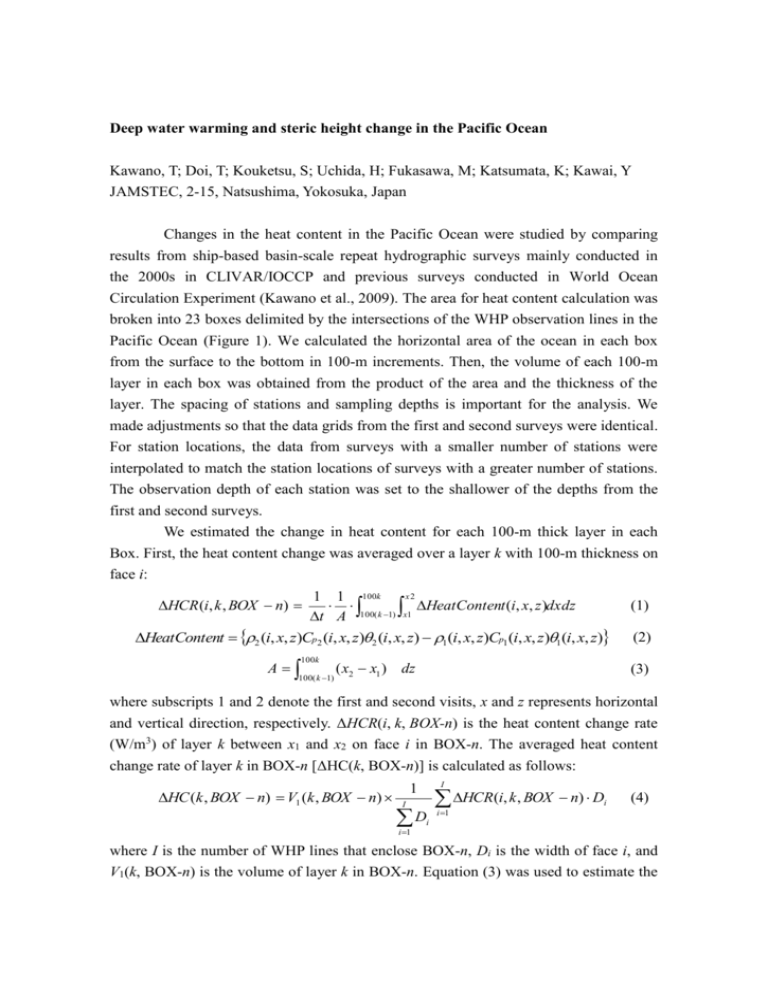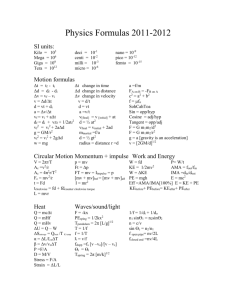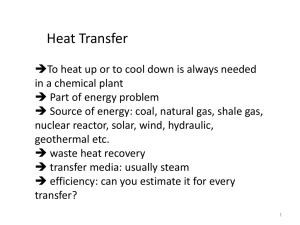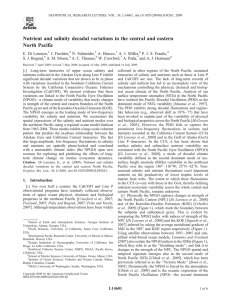Deep Water Warming and Steric Height Change in the Pacific Ocean
advertisement

Deep water warming and steric height change in the Pacific Ocean Kawano, T; Doi, T; Kouketsu, S; Uchida, H; Fukasawa, M; Katsumata, K; Kawai, Y JAMSTEC, 2-15, Natsushima, Yokosuka, Japan Changes in the heat content in the Pacific Ocean were studied by comparing results from ship-based basin-scale repeat hydrographic surveys mainly conducted in the 2000s in CLIVAR/IOCCP and previous surveys conducted in World Ocean Circulation Experiment (Kawano et al., 2009). The area for heat content calculation was broken into 23 boxes delimited by the intersections of the WHP observation lines in the Pacific Ocean (Figure 1). We calculated the horizontal area of the ocean in each box from the surface to the bottom in 100-m increments. Then, the volume of each 100-m layer in each box was obtained from the product of the area and the thickness of the layer. The spacing of stations and sampling depths is important for the analysis. We made adjustments so that the data grids from the first and second surveys were identical. For station locations, the data from surveys with a smaller number of stations were interpolated to match the station locations of surveys with a greater number of stations. The observation depth of each station was set to the shallower of the depths from the first and second surveys. We estimated the change in heat content for each 100-m thick layer in each Box. First, the heat content change was averaged over a layer k with 100-m thickness on face i: x2 1 1 100k HCR (i, k , BOX n) HeatContent (i, x, z )dxdz t A 100( k 1) x1 (1) HeatContent 2 (i, x, z)Cp2 (i, x, z)2 (i, x, z) 1 (i, x, z)Cp1 (i, x, z)1 (i, x, z) 100k A 100( k 1) ( x2 x1 ) dz (2) (3) where subscripts 1 and 2 denote the first and second visits, x and z represents horizontal and vertical direction, respectively. ΔHCR(i, k, BOX-n) is the heat content change rate (W/m3) of layer k between x1 and x2 on face i in BOX-n. The averaged heat content change rate of layer k in BOX-n [ΔHC(k, BOX-n)] is calculated as follows: HC (k , BOX n) V1 (k , BOX n) I 1 I D i 1 HCR(i, k , BOX n) D i 1 i (4) i where I is the number of WHP lines that enclose BOX-n, Di is the width of face i, and V1(k, BOX-n) is the volume of layer k in BOX-n. Equation (3) was used to estimate the heat content change for layers with a thickness of 1000 m in each Box: k 10l 1 HCL(l , BOX n) HC (k , BOX n) V2 k 10( l 1) 1 (5) where ΔHCL(l, BOX-n) and V2(l, BOX-n) are the heat content change rate (W/m3) and volume (m3) of layer l in BOX-n, respectively. The first layer, from the surface to a depth of 1000 m, accounted for 90% of the increased heat content. In this layer, heat content increased in the western Pacific, with large increases in the western Pacific warm pool and near New Zealand, and decreased in the eastern Pacific. The horizontal distributions of heat content change in the third and fourth layers are similar. These layers correspond to the layers with the smallest change in heat content (not shown). In the fifth and sixth (bottom) layers, the heat content increased in almost all boxes. There is a notable heat content increase along the pathway of LCDW and the trend toward the northwest can be seen (Figure 2). These results are consistent with those of Kawano et al. (2006) and Johnson et al. (2007). In particular, the contribution from the deep ocean below 2000 dbar is estimated as 5% of the total. Change in the thickness of layer k of each box is estimated by the similar method by Antonov et al. (2002) as follows; 1 1 hk ( ) k dz (6) k k k where dz is thickness (100 m) of layer k and ρk is density averaged in each box. Density change Δρk is calculated as a function of thermal expansion coefficient (α) and saline contraction coefficient (β) as follows (McDougall, 1987); k , S , P d k , S , P dS k (7) where θ, S and P are potential temperature, salinity and pressure averaged in each box and dθ and dS represent change in averaged potential temperature and salinity, respectively. The steric height change rate was obtained by Δhk divided by the interval of observations. The steric height change rate below 700m averaged over the entire Pacific was calculated to be 0.3 mm/year. Willis et al. (2004) estimated that trend of thermo-steric height in upper 750m was 1.6 +/- 0.3 mm/year and Lombard et al. (2007) estimated that trend of global steric height increase was 1.9 +/- 0.2 mm/year by combining sea level data from satellite altimeters with time-variable gravity data from the Gravity Recovery and Climate Experiment (GRACE) space mission.. When we consider the difference between those trends, that is 0.3 mm/year, to be a steric height increase below 750m, this is consistent with our estimation of steric height change rate below 700m. The steric height change below 2000 dbar averaged over the Pacific Ocean was calculated to be 0.1 mm/year. The contribution of thermal expansion was 0.16 mm/year and that of saline contraction was -0.07 mm/year. The steric height below 2000 dbar increased in the western Pacific and decreased in the eastern Pacific. The largest increase was seen in the Southern Oceans and as well as the western boundary region off the coast of Japan. Reference Antonov J.I., Levitus, S., Boyer, T.P., 2002. Steric sea level variations during 1957–1994: Importance of salinity, J. Geophys. Res., 107 (C12), 8013, doi:10.1029/2001JC000964. Johnson, G.C., Mecking, S., Sloyan, B.M., Wijffels, S.E., 2007. Recent bottom water warming in the Pacific Ocean. Journal of Climate, 20, 5365 -5375. Kawano, T., Fukasawa, M., Kouketsu, S., Uchida, H., Doi, T., Kaneko, I., Aoyama, M., Schneider, W., 2006. Bottom Water Warming Along the Pathway of Lower Circumpolar Deep Water in the North Pacific. Geophysical Research Letters, 33, L23613, doi:10.10292/2006GL027933. Kawano, T., Doi, T., Uchida, H., Kouketsu, S., Fukasawa, M., Kawai, Y., Katsumata, K., 2009. Heat Content Change in the Pacific Ocean between the 1990s and 2000s, Deep-Sea Research Part II, Suginohara Special Issue, in press Lombard, A., Garcia, D., Ramillien, G., Cazenave, A., Biancale, R., Lemoine, J. M., Flechtner, F., Schmidt, R., Ishii M., 2007. Estimation of steric sea level variations from combined GRACE and Jason-1 data, Earth Planet. Sci. Lett., 254, 194–202. McDougall, T.J., 1987. Neutral Surfaces, J. Phys. Oceanogr., 17, 1950-1964. Willis J. K., Roemmich, D., Cornuelle, B., 2004. Interannual variability in upper ocean heat content, temperature, and thermosteric expansion on global scales. J. Geophys. Res., 109, C12036, doi:10.1029/2003JC002260. Figure 1. The 23 boxes delineated for the calculation of heat content change. Boxes connect the intersection points of the WHP observation lines in the Pacific Ocean. The Solid lines indicate the WHP observational lines used for delineating BOXes. Broken lines are additional lines added for BOX division Figure 2. Horizontal distribution of heat content change in the Pacific Ocean between 4000-500 m. Red and blue indicate increasing and decreasing heat content, respectively. The value within each box represents the heat input per volume required (×10–3 W/m3) to produce the changes in each box.



